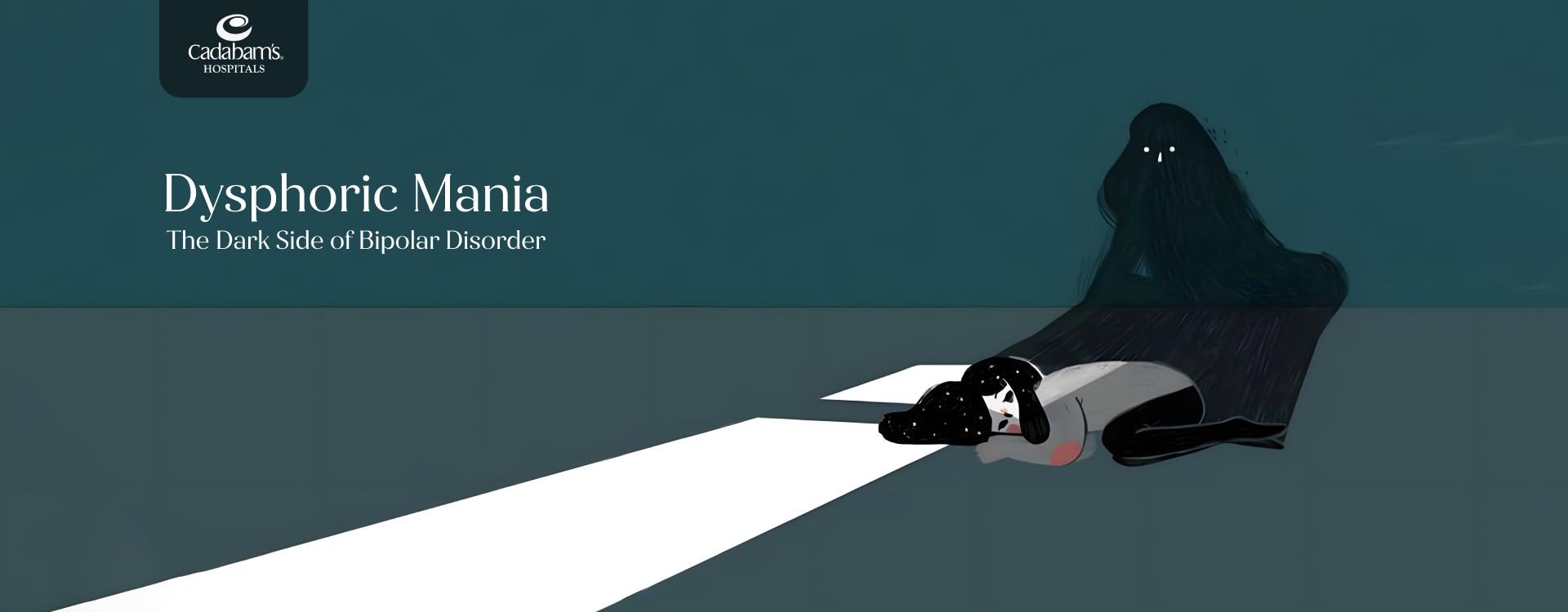Table of Content
Dysphoric Mania within bipolar disorder represents a complex state where individuals experience heightened energy levels alongside intense negative emotions. This can lead to severe consequences, underscoring the importance of targeted interventions. Understanding dysphoric mania is crucial to refine treatment strategies and improve the quality of life for individuals grappling with this challenging facet of bipolar disorder.
What Is Dysphoric Mania?
Dysphoric Mania in bipolar disorder is characterized by the simultaneous occurrence of manic and depressive symptoms. It is also referred to as mixed states or mixed episodes. Individuals report experiencing elevated mood alongside profound negativity, contributing to a challenging emotional state. In the broader context of mental health and bipolar disorder, dysphoric mania highlights the complex nature of mood disorders, emphasizing the need for tailored interventions to address both manic and depressive aspects. Understanding and addressing dysphoric mania is crucial for comprehensive bipolar disorder management.
Euphoric Mania vs Dysphoric Mania in Bipolar Disorder
Euphoric mania and dysphoric mania represent two contrasting mood states within bipolar disorde, often discussed in the context of "Euphoric Mania vs Dysphoric Mania.". Euphoric mania involves an elevated and excessively positive mood, characterized by heightened energy, increased confidence, and a sense of invincibility. In contrast, dysphoric mania combines manic energy with profound emotional distress.
| Feature | Euphoric Mania | Dysphoric Mania |
| Emotional Tone | Primarily positive: elation, joy, grandiosity | Mixture of positive and negative: excitement, racing thoughts, also sadness, hopelessness, irritability |
| Energy Level | Increased energy, decreased need for sleep | Increased energy, but may be accompanied by fatigue |
| Behavior | Hyperactive, talkative, impulsive, risky behavior | Erratic, may include risky behavior and social withdrawal |
| Risk | Increased risk of negative consequences due to poor judgment and impulsivity | Higher risk of self-harm and suicide |
| Overall Experience | Can feel positive and energetic, but often leads to problems | Distressing and emotionally turbulent |
The Role of Dysphoric Mania in the Spectrum of Bipolar Disorder
Dysphoric mania plays a significant role in the spectrum of bipolar disorder, representing a unique and challenging aspect of the condition. In this state, individuals experience both heightened energy and intense emotional distress. This dual nature adds complexity to the understanding of bipolar disorder, emphasizing the need for targeted interventions. Recognizing the role of dysphoric mania contributes to a more comprehensive approach to diagnosis, treatment, and support for individuals navigating the diverse manifestations of bipolar disorder.
Symptoms of Dysphoric Mania
The symptoms of dysphoric mania present a paradoxical blend of depressive and manic symptoms, influencing emotional well-being.
Depressive Symptoms
Depressive symptoms play a significant role in the complexity of managing bipolar disorder, often intertwining with periods of manic energy to create a challenging emotional landscape. Here's a closer look at these symptoms:
- Pervasive Feelings of Sadness: Individuals frequently encounter overwhelming sadness that permeates their daily lives, making even routine tasks feel insurmountable.
- Sense of Hopelessness: A profound feeling of despair and hopelessness becomes a constant companion, overshadowing moments of potential joy and contentment.
- Fatigue and Lack of Physical Energy: Despite episodes of manic energy, there's a noticeable depletion of physical vitality, contributing to an overall state of lethargy and disinterest in physical activities.
- Cognitive Difficulties: The depressive phase may bring about significant challenges in focus and concentration, hindering the ability to perform tasks that require mental clarity and sharpness.
- Emotional and Physical Distress: The combination of emotional turmoil and physical exhaustion amplifies the distress experienced, making the management of bipolar disorder particularly taxing during periods of dysphoric mania.
Manic Symptoms
During dysphoric mania, individuals may display manic symptoms that significantly affect their behavior and decision-making processes:
- Elevated or Irritable Mood: There's an abnormal increase in mood, often perceived as an extreme sense of well-being or irritability.
- Surge in Energy and Restlessness: Energy levels dramatically increase, leading to restlessness and an urge to engage in numerous activities.
- Heightened Activity and Impulsivity: The increase in energy often results in more activities and impulsive actions without much consideration for the consequences.
- Racing Thoughts: Thoughts may race uncontrollably, contributing to mental hyperactivity and making it challenging to concentrate on specific tasks.
- Impaired Judgment: The combination of these symptoms can impair judgment, leading to risky behaviors and poor decision-making.
Causes and Risk Factors of Dysphoric Mania
While the exact cause of dysphoric mania remains elusive, researchers have identified several factors that contribute to its development. Understanding these factors can offer valuable insights for both prevention and managing the condition.
Genetic Factors
Genetic predisposition plays a crucial role in the development of dysphoric mania within bipolar disorder. Individuals with a family history of bipolar disorder may have a higher likelihood of experiencing dysphoric mania due to inherited genetic factors. While genes don't directly cause the condition, they influence brain development and function, making individuals more susceptible.
Brain Chemistry
Neurotransmitters, the brain's chemical messengers, play a crucial role in regulating mood. Imbalances in key neurotransmitters like serotonin, dopamine, and glutamate are implicated in both mania and depression. Disruptions in these brain chemicals influence mood regulation and may trigger the onset of dysphoric mania.
Stressful Life Events
High levels of stress or exposure to significant life events can act as triggers for dysphoric mania. Traumatic experiences, major life changes, or chronic stressors may exacerbate the symptoms of bipolar disorder, leading to the manifestation of dysphoric mania, especially in individuals already predisposed. Stress disrupts the brain's delicate balance, making it more vulnerable to mood swings.
Substance Use
Substance abuse is linked to an increased risk of dysphoric mania. Substance use, including alcohol, recreational drugs, and even certain medications can disrupt the delicate balance of neurotransmitters, aggravating mood instability and contributing to the onset of dysphoric mania.
Specific Health Conditions
Certain health conditions, such as thyroid disorders, neurological conditions, brain tumors or sleep disturbance may potentially trigger dysphoric mania. It's crucial to address any underlying health conditions for holistic management.
Diagnosis of Dysphoric Mania
Diagnosing dysphoric mania can be challenging due to its unique blend of manic and depressive symptoms. However, with careful evaluation and the right tools, mental health professionals can accurately identify this complex condition and pave the way for effective treatment.
Key Steps in Diagnosis
- Detailed Clinical Interview: Involves exploring mood, thoughts, behavior, sleep patterns, family history, and any potential triggers.
- Suicidal Thoughts Inquiry: Assessing the presence of any suicidal thoughts or tendencies.
- Medication Review: Examining current medications to assess their potential contribution to symptoms.
- Exclusion of Other Conditions: Ruling out other medical conditions with similar symptoms, such as thyroid disorders or substance abuse, is essential for a definitive diagnosis.
Treatment Approaches for Dysphoric Mania
Dysphoric mania requires a multifaceted approach to treatment. Here's an overview of key strategies:
Medication
- Mood stabilizers: Lithium, lamotrigine, valproate, and carbamazepine medications are commonly prescribed to regulate mood swings and stabilize emotions.
- Antidepressants: Used cautiously because they might trigger mania in some cases, but carefully selected ones can help manage depressive symptoms within dysphoric mania.
- Antipsychotics: These medications help manage psychotic symptoms and can be beneficial in controlling the intense emotions associated with dysphoric mania. Examples include risperidone, olanzapine, quetiapine, and aripiprazole.
Psychotherapy Techniques
- Cognitive-Behavioral Therapy (CBT): CBT targets distorted thought patterns, helping individuals manage their emotions, and develop coping strategies for mood fluctuations.
- Dialectical Behavior Therapy (DBT): Specifically designed for emotional regulation, DBT combines cognitive-behavioral techniques with mindfulness. It helps individuals tolerate distress, manage emotions, and improve interpersonal effectiveness.
- Interpersonal and Social Rhythm Therapy (IPSRT): Focuses on stabilizing daily routines and improving interpersonal relationships to manage the disruptive effects of dysphoric mania.
Electroconvulsive Therapy (ECT)
In severe cases of dysphoric mania, especially when medication and therapy prove ineffective, electroconvulsive therapy may be considered as a last resort. It involves controlled electrical stimulation to induce a brief seizure, impacting brain chemistry to alleviate symptoms.
Lifestyle Modifications
- Regular sleep schedule: Maintaining a consistent sleep pattern is crucial for mood stability.
- Healthy diet: Eating nutritious foods provides the body and brain with essential nutrients.
- Regular exercise: Physical activity helps manage stress and improve mood.
- Stress management techniques: Practices like yoga, meditation, or deep breathing can help manage stress and regulate emotions.
- Avoiding substance abuse: Consuming alcohol or drugs may worsen symptoms and interfere with treatment.
Managing Life with Dysphoric Mania
Living with dysphoric mania brings forth the daily challenge of navigating unpredictable mood swings and emotional intensity. While acknowledging the complexities of this condition and the adjustments it necessitates, there is hope in the potential for effective management. If you or a loved one is seeking support and guidance, consider reaching out to professionals at Cadabam’s. Our team offers a combination of personalized treatment plans, combining medication, therapy, and lifestyle adjustments to foster stability and well-being.
Pathways to Coping with Dysphoric Mania with Cadabams
Cadabam’s is a trusted mental health organization offering specialized pathways to help individuals cope with the challenges of dysphoric mania. Our experienced team understands the complexities of dysphoric mania and provides a supportive environment for learning and implementing effective coping mechanisms.
Here's why Cadabam’s is different:
- We delve deeper: We don't just treat symptoms; we explore the underlying causes and triggers of dysphoric mania.
- Tailored therapy: We offer a range of evidence-based therapies like CBT and DBT, specifically adapted to treat dysphoric mania.
- Holistic approach: We consider individuals’ lifestyle, sleep, diet, and stress management for a well-rounded approach.
- Compassionate support: We create a safe and understanding space where one can share their experiences openly.
Don't settle for just "managing" your symptoms. With Cadabams, regain control, build resilience, and experience true emotional stability.
FAQ
1. What is dysphoric mania in bipolar disorder?
Dysphoric mania in bipolar disorder is a complex state where individuals simultaneously experience elevated mood and profound emotional distress.
2. What are the 3 types of mania?
Bipolar mania takes three forms: euphoria (joyful highs), dysphoria (mixed joy & sadness), and delirium (severe, disorganized mania). Imagine a spectrum - euphoria at one end, delirium at the other, with dysphoria's emotional turmoil in between
3. What is an example of dysphoric mania?
An example of dysphoric mania in bipolar disorder might involve a person experiencing heightened energy levels, impulsivity, and restlessness while concurrently grappling with intense feelings of sadness, hopelessness, and emotional distress.
4. How do I recognize a mixed episode in myself before it’s too late?
Common signs include heightened energy, racing thoughts, and impulsivity, along with symptoms of depression like sadness and hopelessness. Monitor your mood and seek professional help if you notice a combination of manic and depressive symptoms. Regularly communicate with mental health professionals and maintain a mood journal. Early recognition and proactive steps enhance the chances of managing mixed episodes effectively.
5. How do you stop dysphoric mania?
While there is no “stopping” dysphoric mania, managing it effectively is possible. Timely medication, psychotherapy, maintaining stable routines, stress management, avoiding substance use, and building strong support networks can help individuals regain emotional stability. Regular communication with healthcare professionals is vital for ongoing monitoring and intervention.
How Cadabam's Help you for Addiction?
- 410+ Professional Consultants
- 1,00,00+ Happy Faces
- 120+ Currently Seeking Treatments









